Explore what RevOps is, how it works, and how to set it up in your organization.
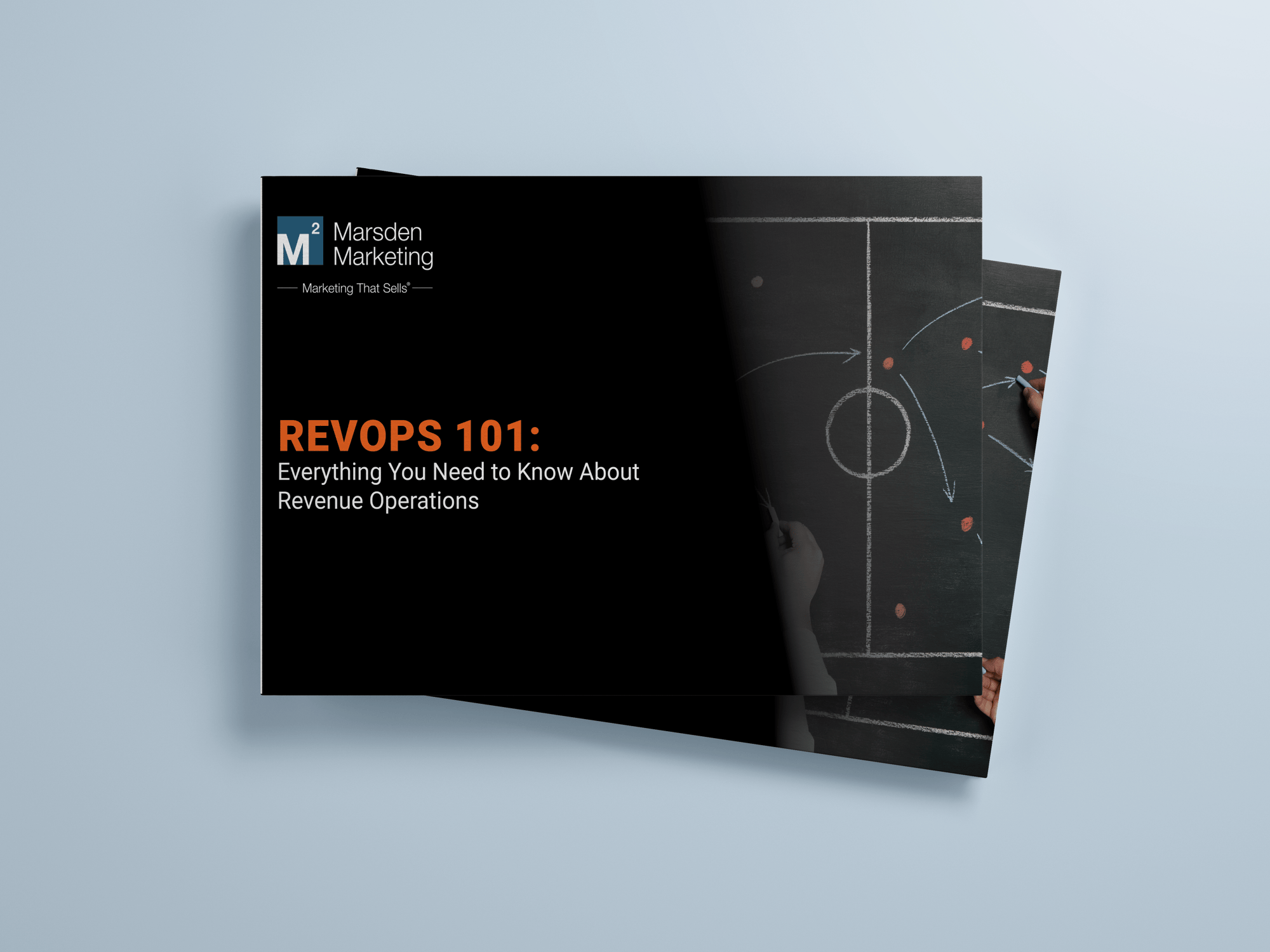
The writing is on the wall. You need to change the way you operate if you want to drive predictable and sustainable growth today.
It's why organizations are increasingly leveraging the revenue operations (RevOps) model. Growth leaders can proactively and confidently identify growth opportunities by aligning all go-to-market functions (sales, marketing, and customer success) toward unified business goals and outcomes.
Yet knowing if RevOps is right for your business can be challenging. You may need help understanding what it is, how it works, or how to best implement it. And it can take time to determine if now is the right time to implement this new model.
As a B2B marketing agency focused on helping B2B companies drive revenue growth, we often suggest a RevOps approach to our clients if they’re looking to:
RevOps is the end-to-end B2B function of integrating and aligning your sales, marketing, and customer success teams to maximize revenue growth. The goal is to remove organizational silos, improve efficiency, and provide visibility throughout the revenue lifecycle to facilitate revenue predictability and growth. Data tools enable the ability to align go-to-market functions under one umbrella by providing a unified source of information.
Since all revenue processes and workflows are interconnected under the RevOps model, it helps you:
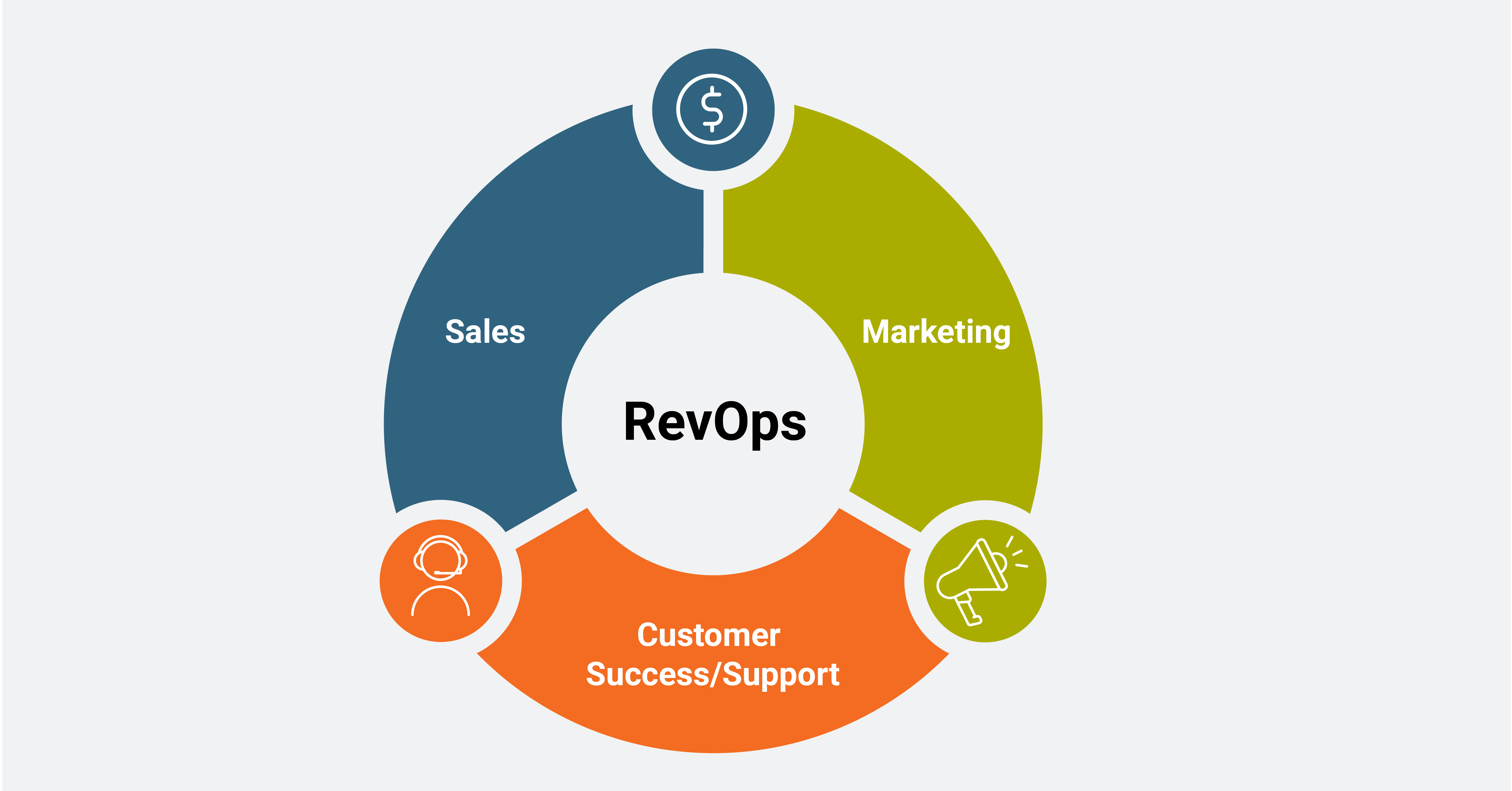
Revenue operations is not just critical because the business environment is becoming more complex and uncertain. It's also important because it's increasingly becoming a priority for the board. Private investors are tying a firm's value to its ability to generate revenue growth. They’re using it as a means to justify a purchase price that can exceed EBITDA by 13 times.
This can explain why you might be seeing a push from the board to transform your organization’s business model. Not to mention that research shows that organizations that successfully align their commercial teams, processes, and infrastructure can improve long-term growth prospects by over 50% and contribute 5 to 10 points of bottom line profit in the short term.
But outside of these trends, a RevOps model is simply a necessity for running a business in the 21st century. The way customers purchase products and services has changed. And as technology advances, it will continue to fragment the customer journey — making it harder for teams to deliver a seamless and consistent experience.
To be successful, your revenue-generating teams need more transparency and accountability across the entire revenue funnel to deliver the experiences customers now expect and demand. They need to avoid the disconnect between what customers buy and what they need. This requires integrating the right set of tools to enable your teams to have full visibility into every customer interaction.
Increased collaboration, alignment, efficiency, and revenue are natural by-products of adopting a RevOps model. But those aren’t its only benefits. Beyond the obvious, it can help you gain a competitive advantage.
A Forrester report showed that better decision-making and forecasting extend the benefits of RevOps as it provides growth leaders with greater visibility into improvement areas and opportunities for growth. Consequently, organizations with tighter go-to-market alignment grow revenue 58% faster and are 72% more profitable. And that’s not all.
Boston Consulting Group’s (BCG) report also highlighted similar benefits of tightly aligned go-to-market functions such as:
Revenue Operations is more than an organizational structure. It’s a mindset shift in how teams work together to generate revenue growth. Through RevOps, you gain a holistic view of your entire organization, enabling you to better understand your customers and revenue streams. At its core, the Revenue Operations framework is built on four pillars.
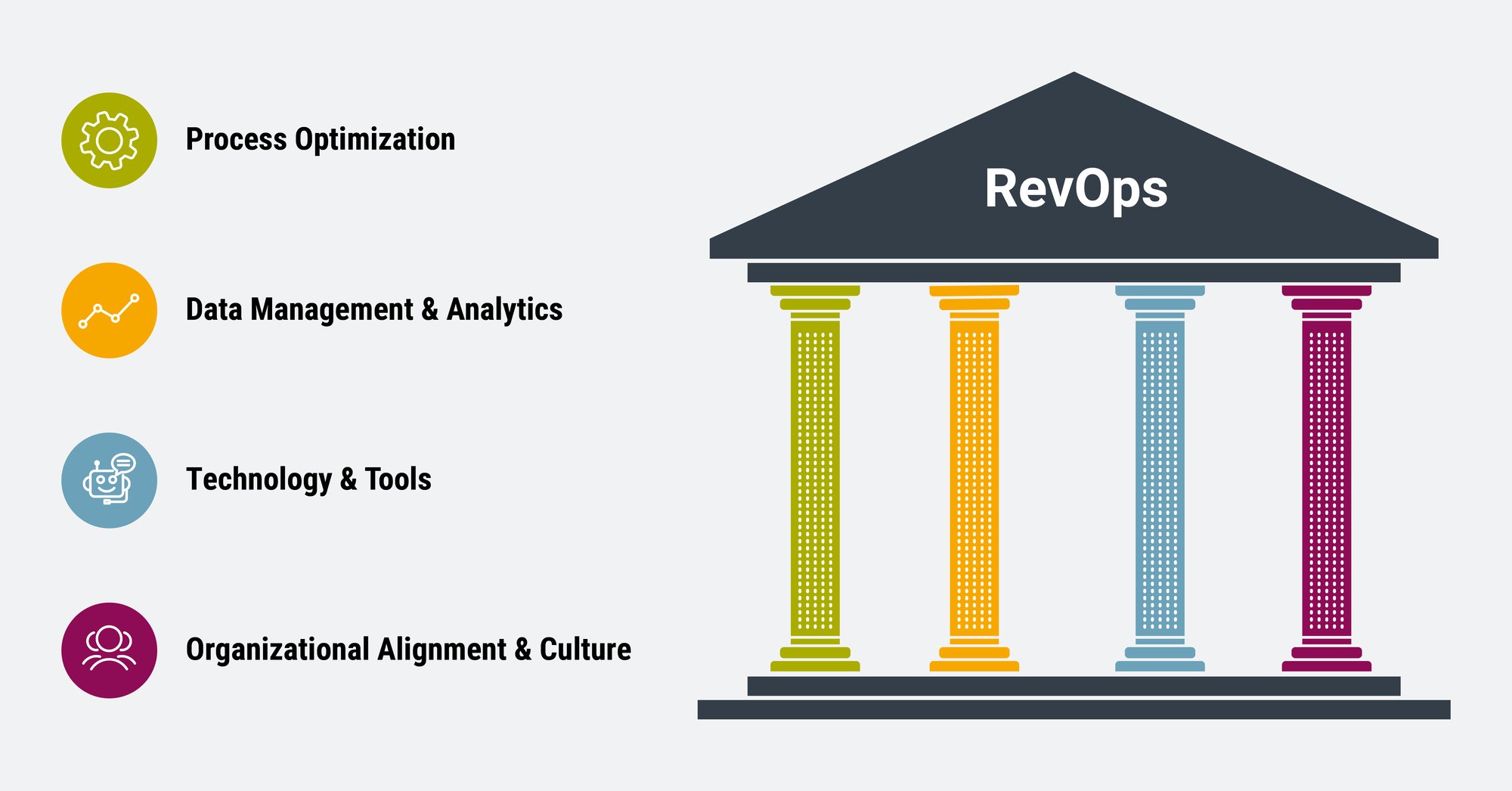
You need to establish a standard process across your commercial team to ensure you deliver a consistent customer experience across the customer journey. Processes to revisit under this new model include lead management, opportunity management, deal closure, customer onboarding processes, and more.
Your commercial team needs access to the same data set to make informed, data-backed decisions that result in predictable revenue growth. This means monitoring and measuring key performance indicators (KPIs), identifying areas of improvement, and leveraging data to uncover new areas of growth like cross-selling and upselling opportunities.
Your tech stack is the lynchpin of your entire revenue operations. It’s what connects your entire team to ensure strategic alignment, collaboration, and streamlined processes. But it should also give you and your team a comprehensive, 360-degree view of your customers. As you work on selecting the right tools, keep this in mind as you evaluate which ones to implement and integrate to achieve your goals and get a full picture of your customers.
RevOps requires a fundamental shift in your organization's DNA. Go-to-market functions must operate as a single revenue team for RevOps to work. Focus on fostering a culture of collaboration, transparency, and continuous improvement. Ongoing communication, education, and support from leadership are also required to ensure and maintain alignment.
Implementing RevOps requires a strategic and systematic approach. It’s a mindset shift in how an organization operates and works, which means ensuring you’re getting buy-in early in the processes is key. So how can you ensure you’re taking the right steps in implementing this structure? Here’s the approach we typically advise our clients to take that has proven successful.
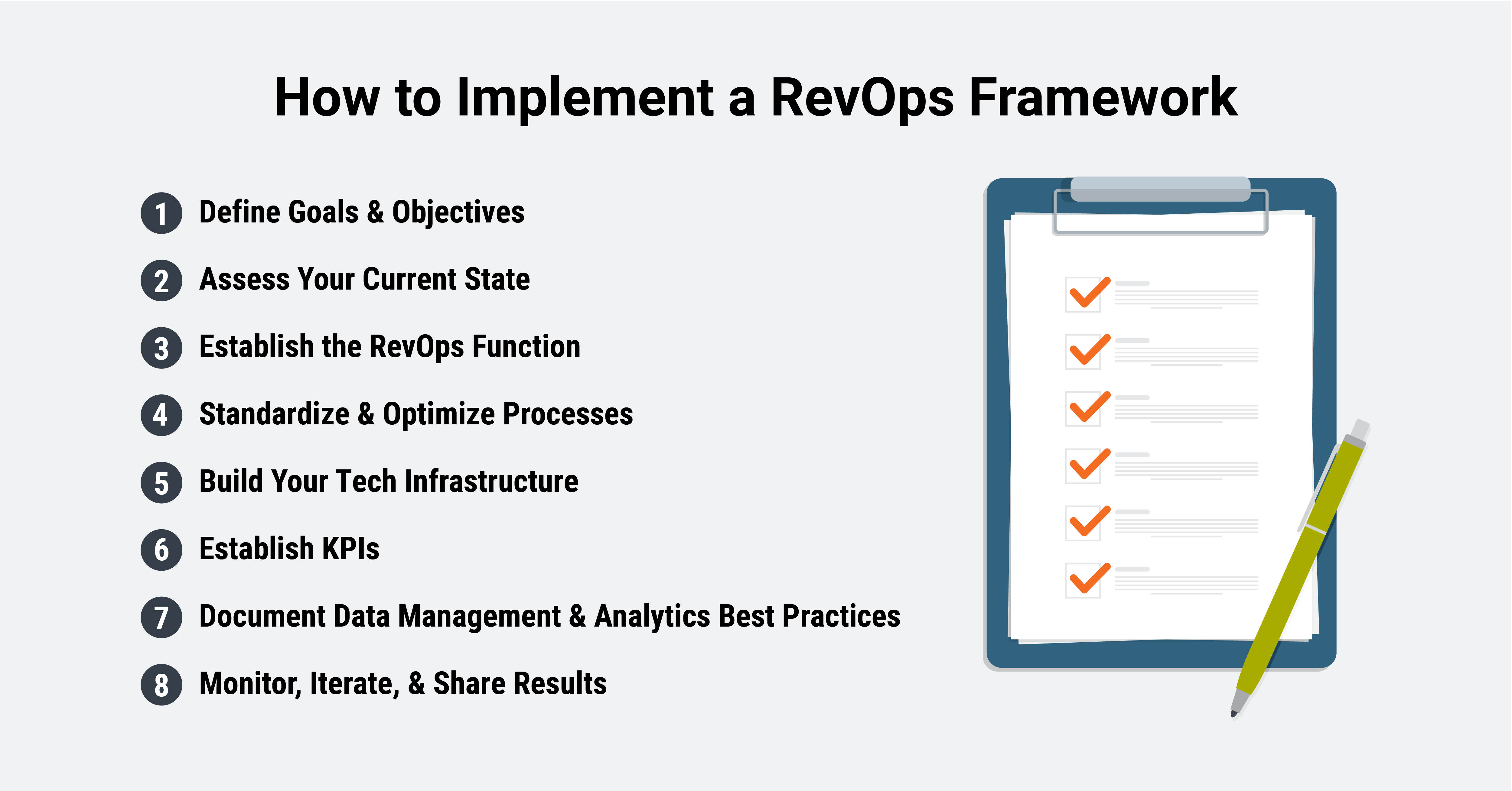
Like most initiatives, you’ll want to start by defining why you need a Revenue Operations function and what you hope to accomplish. Taking this step will make it easy for your leadership team and other stakeholders to understand what the risk is if this new model is not implemented and aligned across the organization.
An example of a goal could be that you're looking to identify what factors contribute to driving predictable growth among a key customer segment. Then you can make the business case of how RevOps solves this issue and how you plan to accomplish this goal, such as removing data siloes and creating closer alignment with sales, marketing, and customer success.
Leverage the SMART (specific, measurable, achievable, relevant, and time-bound) framework to make your goals and objectives more impactful. This framework will ensure that your goals are clear and achievable while addressing leadership and key stakeholders' concerns.
Conduct a current state analysis of your commercial team, customer journey, tools, and data management practices. Identify areas of misalignment, inefficiencies, and gaps. The result of this exercise provides you with a roadmap for setting up your revenue operations team and establishing a baseline for measuring the impact of your RevOps initiatives.
"Leadership should start by diagnosing the current state of their GTM processes and the operations behind them."
Source: Revving Up Go-to-Market Operations in B2B, Boston Consulting Group
The structure of your RevOps function or team will vary depending on your organization's size, the complexity of your sales processes, and your products or services. Larger organizations tend to have a more matrixed RevOps team structure made up of highly specialized roles with a singular focus aligned to the specific needs of the business and RevOps function.
You’ll typically find a Director of Revenue that reports to the Chief Revenue Officer with a direct line to the CEO in a larger organization. From there, managers across the commercial team report to the Director of Revenue Operations with additional roles supporting the RevOps function, such as System Analysts, Process Managers, Sales Enablement Specialists, and others.
The team structure in a smaller organization, in contrast, is much leaner and more generalized. It’s usually comprised of a team of one with a RevOps Lead or a Revenue Operations Manager reporting to the CEO. Under this model, the RevOps lead typically works with operations generalists across the commercial team and must be flexible and adaptable with a broad skill set to address evolving needs. No two days are alike.
Some days, the RevOps leads can focus on sales enablement and other days on cleaning up data and managing ongoing projects. RevOps leaders might even supplement their function with freelancers, marketing agencies, and part-time workers to fill in gaps as the RevOps function scales and matures.
Interdepartmental visibility is key within the RevOps model. It’s what will enable your team to easily make data-driven decisions, identify growth opportunities, and better forecast and plan. But before you look to technology to drive closer alignment and streamline key processes, you must first focus on laying down the framework for how your go-to-market teams will work together.
That means mapping the customer journey, identifying key workflows, and ensuring processes are standardized and optimized across the commercial team. This can include creating lead scoring and qualification criteria, for example, or implementing a new sales methodology or playbook. Either way, the goal is to have everyone operating as a single unit.
With step four complete, you can start evaluating your current tech stack to see what technology you need to support your new structure. Identify any gaps or opportunities for improvement or consolidation.
Remember, the goal of revenue operations is to gain a holistic view of your customer, so keeping an eye on what platforms will enable you to consolidate your data in one place is vital.
Some necessary tools and capabilities to consider to support your RevOps function include:
The main goal of your RevOps program is to drive revenue growth. Establishing RevOps KPIs will enable you to quantify and measure the performance of your revenue operations while ensuring team alignment. As you work with your commercial team to develop workflows and processes, make sure to agree on which metrics to track. Not all metrics are created equal, and each metric will provide a different set of insights, so select the ones that make the most sense for your business goals and strategy.
For example, if you want to grow revenue from your existing customer base, you wouldn’t track win rates. Instead, you might look at customer churn and average revenue per user (ARPU) to better understand how to achieve this and if you're on the right track.
A comprehensive data management strategy is a vital component of any RevOps function. Document your best practices for collecting, cleaning, storing, and analyzing data. Having one source of customer data will make it easier for your revenue-generating teams to move quickly and agilely while driving continuous improvement across marketing, sales, and customer success operations.
Make it a habit to continuously monitor and improve the organization's growth trajectory by reviewing data. Identify improvement opportunities and iterate on your processes, tools, and data management practices. Then communicate the findings and observations with your team to foster a culture of transparency and accountability while encouraging continuous learning, innovation, and adaptation.
You can’t drive predictable revenue growth without data. Yet knowing what to measure and what to ignore can be difficult. The solution? Select a few key metrics that best fit your goals and objectives, and then explain the relationship between them and your business goals with your go-to-market teams. While this isn’t an exhaustive list of possible Revenue Operations metrics you can track, it can provide some ideas on what will fit your needs best.
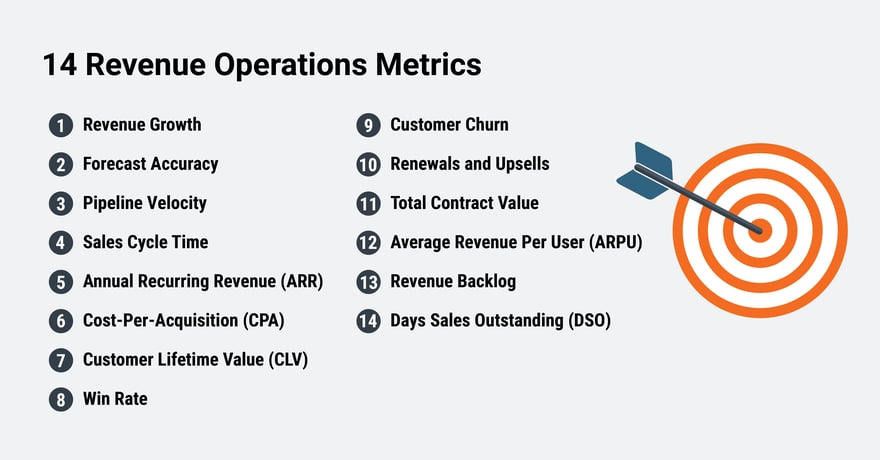
Revenue growth is the measure of your company’s ability to generate income and sustain operations. A positive growth rate provides insights into the company’s financial health, growth potential, market position, and demand. Tracking this metric over time helps you identify market trends that can help you pivot and adjust your revenue operations strategy as needed.
Forecast accuracy refers to your company's ability to predict revenue successfully as a percentage. It helps determine how well you can predict sales, how well your business manages its sales, and whether it brings in enough money.
Pipeline velocity is the time it takes for a prospect to move through each phase of your revenue pipeline. This metric provides insights into optimizing your funnel by seeing which parts of the revenue cycle prospects spend the most time in.
Sales cycle time refers to how long it takes for a prospect to convert into a customer. Knowing how long your deal cycles are can provide insight into how to expedite the process and makes it easier to predict revenue more effectively. High velocity means the sales process is organized and structured. A slower velocity can indicate problems within the sale cycle.
ARR is the repeat revenue your business brings in over the year. This metric enables you to identify your most valuable customers. You can study this cohort more closely to understand how to bring more customers in via marketing campaigns and sales activities.
CPA is the cost to acquire a new customer, such as advertising spend and promotional projects, among others. This metric enables you to identify areas to cut costs and improve efficiency — helping you maximize the return on investment for your revenue activities while increasing profitability.
CLV refers to the amount of revenue you plan to generate from the average customer through their relationship with your business. Calculating this number helps you identify which customers will most likely make repeat purchases.
The number of sales opportunities that result in converted customers is your company's win rate. It gives you insights into sales performance and how you can improve sales processes. For example, you can leverage the tactics of a high sales performer to upskill other sales reps.
The percentage of customers that stop doing business with you during a given period is your company's customer churn. Clarity around factors that are more likely to lead to customer churn can help you identify ways to improve customer retention.
Renewals and upsells refer to the revenue you can expect to generate from selling new products/services to existing customers or extending their contracts. This number enables you to predict revenue by identifying your top customers.
Total contract value is the value or worth of a contract. By calculating this number and cross-comparing it with your customer acquisition cost (CAC), you can determine the ROI of your efforts, which enables you to craft a profitable strategy that will benefit your company in the long run.
ARPU is the worth of every active customer over a time period. This metric explains how many customers you need to sustain your business. It also gives you insights into product-market fit across your target audience, the effectiveness of your marketing efforts, and your business's financial performance.
Revenue backlog is the amount of unreported revenue. This calculation measures how much money you need to collect and identifies whether you bring in enough revenue for your objectives. It also provides insights into potential growth areas and revenue opportunities and can help you plan for future production and capacity needs.
DSO is the average amount of time it takes to collect payment for a sale or service. A high DSO can impact cash flow and the overall health of your organization. Tracking it can help you identify needed workflow improvements to reduce the risk of financial instability and improve cash flow.
Roadblocks will happen whenever you're shifting to a new way of operating. And we’ve seen our fair share of challenges that can hold an implementation back. Here are the top four we’ve seen.
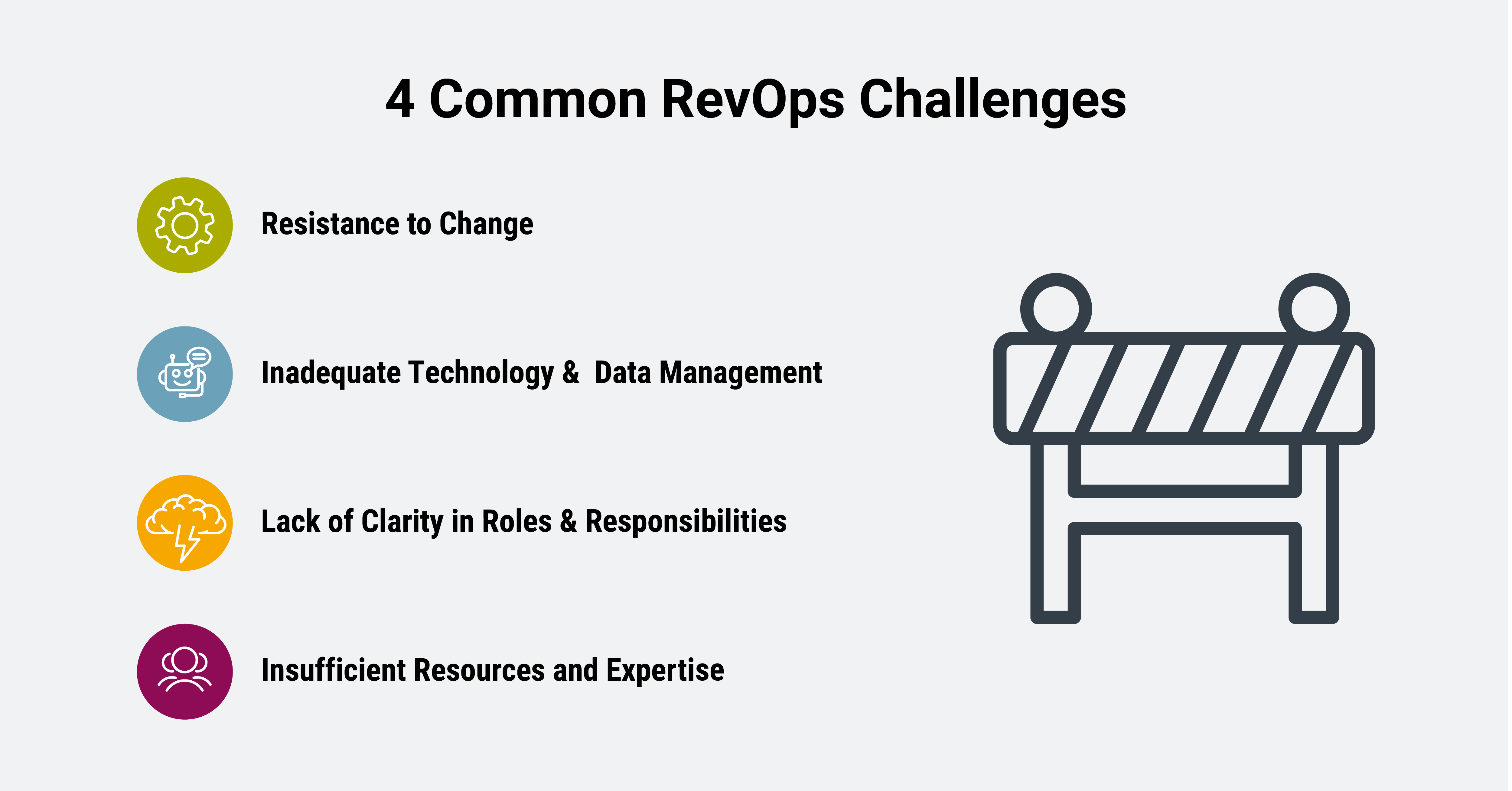
A shift in processes, roles, and infrastructure can spark fear in employees. This can make them uneasy and resistant to change. Overcome this hurdle by using clear and consistent communication when explaining the shift to the new model. Leveraging change management best practices can prove fruitful in facilitating a smooth transition.
The effectiveness of your RevOps program is greatly improved with the right tech infrastructure. Set yourself up for success by auditing your current tech stack. Then map your customer journey and cross-compare it with your tech audit to identify gaps and tools you need to run operations successfully. The key here is to focus on gaining a 360-view of your customer in one place.
Redefining roles and responsibilities or creating new ones are bound to happen with RevOps. But it can cause confusion if not properly communicated to your go-to-market teams. Reduce confusion by documenting your RevOps structure and clearly defining roles and responsibilities. Share the new approach with team members on one-on-ones and hold regular training sessions and workshops as needed.
Lack of expertise and resources are cited as top challenges that hold companies back from adopting RevOps. Workaround this gap by engaging with external experts or consultants to help you quickly build your RevOps programs. B2B marketing agencies like Marsden Marketing can provide the support and expertise you need as you get started.
Getting Started With RevOps
The time is now for RevOps. You can no longer afford to operate as you have in the past. Best-of-breed companies have proven this and are increasingly making the shift to revenue operations. Gartner predicts that 75% of the highest-growth companies in the world will deploy RevOps by 2025.
But ensuring you implement RevOps correctly means identifying every possible scenario that could impact adoption and working around it to ensure your program is headed in the right direction. This can make standing up RevOps complex — expanding your lead time to get it running.
As a B2B marketing agency, we’ve seen what works and what doesn’t. Our work with clients spanning SaaS, Technology, FinTech, and more has given us unique insights on maximizing your return on investment. From identifying the right channels to the technologies you need to make it happen, we can provide you with a roadmap for getting started.
To learn more about our capabilities or to get an initial take on how we can help, reach out to our team today to explore how Marsden Marketing can help support your revenue operations goals.
B2B growth marketing+pr agency Trevelino/Keller acquired Marsden Marketing in 2024, including its industry-leading MM Growth Marketing solution, powered by a data-forward approach rich in technologies including HubSpot, Salesforce and Pardot.
1042 Northside Drive NW
Suite 960
Atlanta, GA 30318
(404) 214-0722
info@marsdenmarketing.com